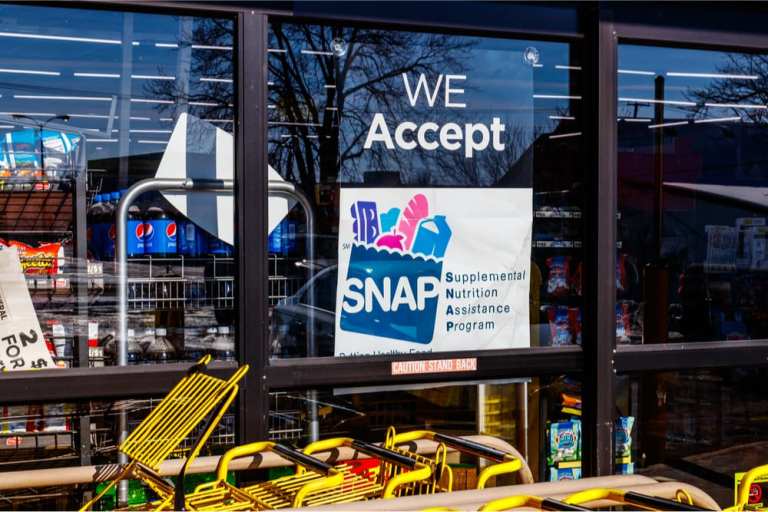
While digital grocery had been a growing area of interest for consumers in a pre-COVID-19 world, the pandemic has sent it into overdrive. Looking at the past several weeks of PYMNTS consumer survey data, four times more consumers are buying groceries online instead of going into the grocery store these days.
The reason for that veritable explosion over the last several weeks? Health concerns, largely. Despite the protective measures that many grocery stores have put in place for consumers and staff, two-thirds of consumers we surveyed (66 percent) say they think going to the grocery store puts them at risk of getting the virus.
But according to a recent New York Times report, digital grocery shopping isn’t an option for the roughly 38 million Americans currently collecting benefits from the Supplemental Nutrition Assistance Program (SNAP, formerly known as food stamps). This forces them to walk supermarket aisles nationwide whether they think they’re endangering their safety or not.
“With any chronic health condition, your body is working so hard to keep you stable, so there is not a lot of bandwidth for something like Covid-19,” Austin-based SNAP beneficiary Ariel Smith told the Times. Smith suffers from a chronic medical condition affecting her connective tissue and laments the fact that she can’t use her SNAP to easily shop online.
Digital grocery benefits for SNAP recipients recently came to the forefront thanks to COVID-19, but the issue isn’t really new. The government first began investigating the prospect of allowing SNAP card recipients to pay for their groceries online four years ago, in 2016, and had begun to design a pilot program with grocery players. By early 2017, a pilot program was in the early phases of development, with companies like Amazon, Walmart and ShopRite among the early entrants looking to design a digital payments path for SNAP recipients.
“Online purchasing is a potential lifeline for SNAP participants living in urban neighborhoods and rural communities where access to healthy food choices can be limited,” then-U.S. Agriculture Secretary Tom Vilsack said in a statement announcing the effort. “We’re looking forward to being able to bring the benefits of the online market to low-income Americans participating in SNAP.”
But much they may have been looking forward to it, the gap between the concept and the first rollout of the pilot phase was incredibly long — and it is still very limited. The first round of digital SNAP payments went live in 2019 in a handful of states — New York was the first to join a year ago, and Washington, Alabama, Iowa, Oregon, Nebraska and Florida have since gotten their programs up and running.
It’s a start, consumer advocates note, but not a good enough one considering Congress approved this program six years ago and yet it still remains largely unavailable to consumers who might very much want or need it.
“It should have happened yesterday, and it should be accessible to everyone,” said Patricia Baker, a senior policy analyst at the Massachusetts Law Reform Institute, an advocacy group for low-income people.
An opinion, incidentally, that some retailers, particularly Walmart, concur with. Though Walmart is a participant in the U.S. Agriculture Department’s digital SNAP payments for groceries program, it has developed in parallel a workaround to the USDA’s limitation. In 2017, Walmart began developing a program that allowed SNAP users to order their groceries online and mark “SNAP” as their payment method. When they arrived to pick up their groceries, a Walmart employee physically scanned the card at the Walmart location — like a regular in store purchase. As of last year, Walmart had expanded that program to all 2,500 of its U.S. pickup locations.
Other grocery retailers — HyVee and Safeway most notably — are currently working to develop similar workaround programs, according to the Time report, but configuring a system to allow orders online but in-person payments with SNAP is not quite so easy as turning on a light. Walmart got an early jump with a two-year head start — likely because it serves a large pool of those 38 million or so SNAP recipients. Walmart derives about 4 percent of its U.S. sales from food stamp purchases (~$22 billion) , according to UBS Analyst Michael Lasser — though Walmart has neither confirmed nor denied that figure.
Whatever the specific number, however, Walmart clearly had a very compelling reason to get up and running much faster than the federal government, and had its SNAP workaround functioning chainwide a year before the pandemic started. Grocery stores that didn’t start until the pandemic was underway? That, the Times noted, means there will be delays since those same grocery stores are trying to solve a series of problems simultaneously at present.
The good news is that the SNAP pilot program, now under increased public pressure, has stepped on the gas, some. As of this week California and Kentucky have also recently joined the pilot states — and in the near (but still not exactly defined) future, the District of Columbia Arizona, Idaho, North Carolina, West Virginia, Missouri, Texas and Vermont have signed up for the program. Once they are up and running the pilot program will cover more than half the country’s SNAP participants, according to the Agriculture Department.
But when they will be up and running, that remains a mystery. And what will happen for the other 50 percent of SNAP beneficiaries who don’t live in a state where the pilot is forecast for even the vague near future? Well those customers, it seems, have two choices at this point.
They can shop in store and take their chances; or they can download the Walmart app and try to figure out how close the nearest grocery pickup location is.